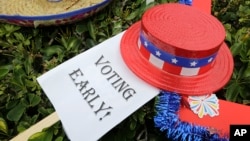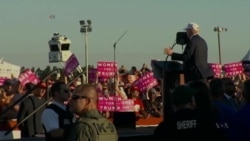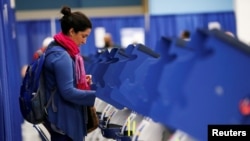Early in-person voting for the U.S. presidential election is underway in several states, including the battleground states of Florida and Colorado.
Polling places opened Monday in 50 counties in Florida, including the state’s largest counties — Broward, Duval, Hillsborough, Miami-Dade, Orange and Palm Beach. In Colorado, early voting centers opened Monday morning in all 64 counties across the state.
Also Monday, polling places began opening in Alaska, Arkansas, Massachusetts and Texas.
Vote by mail
Early voting by mail has been underway for weeks in many states. However, in-person early voting recently began in some states, allowing people to travel to voting centers to cast their ballots, in much the same way as voting on Election Day. So far, more than 5 million ballots have been cast.
Twenty-one states and the District of Columbia offer some in-person early voting, while many others allow absentee mail-in voting without having to provide an excuse for not being able to come to the polls.
Three states, Oregon, Washington and now Colorado, have enacted a vote-by-mail system in which all registered voters receive their ballots in the mail several weeks before Election Day. Voters can then mail their ballots back or drop them off at designated collection points through Election Day.
Recent data from the Pew Research Center indicates that early voting totals this election may well swell beyond 50 million, the most ever. That would be a significant proportion of the overall voter turnout, which is estimated at 130 million ballots.
More voters opt to vote early
In 1996, about 10 percent of voters used an alternative voting methods, either voting early or casting absentee ballots, according to U.S. Census data. Four years ago, in the last presidential election, that figure had tripled, to nearly 33 percent.
And in some individual states, that number is much higher. More than half of the ballots cast in the 2012 election in Nevada, Arizona, Texas, North Carolina, Montana, New Mexico and Tennessee were either early or absentee, according to Pew researchers.
Unlike most democracies, the U.S. does not have a centrally administered electoral system, meaning each state — and in some cases, even each county — determines how and when residents can vote.
Absentee voting began more than a century ago during the American Civil War, as a way for soldiers in combat to send their ballots back home. By the mid-20th century, most states had adopted some form of absentee voting, although it was restricted, usually requiring specific evidence that a voter was unable to cast a ballot in person on Election Day.
California, Oregon and Washington were among the first states in the 1970s and 1980s to allow voters to choose to cast absentee ballots without providing a specific reason. Today, 27 states and the District of Columbia allow “no excuse” absentee voting for their residents.
Regardless of how or where they vote, more and more Americans are acting early on their electoral choices. This has begun to alter political parties’ traditional campaign exhortations for everyone to get out and vote on Election Day.
Apart from the convenience early voting offers to most people, the trend can either help or hurt candidates whose campaigns peak just before Election Day. Campaign rhetoric during the last weeks before voting day this year will have relatively little or no effect on large numbers of voters.































